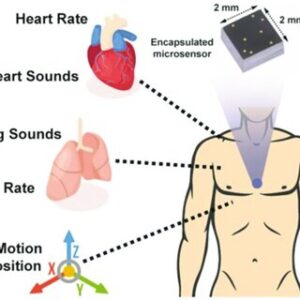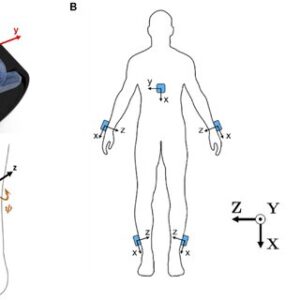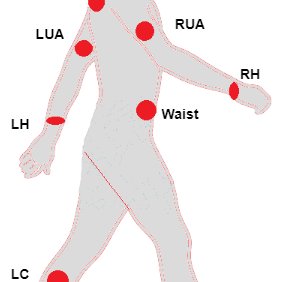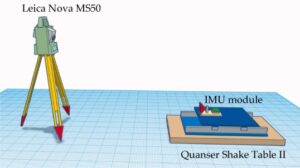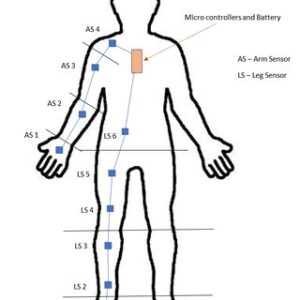

Forward Head Posture (FHP) is the modern-day “tech neck” dilemma caused by endless screen time and poor posture habits.
If you have ever found yourself craning over your phone like a giraffe, you’re not alone.
This common issue puts excessive strain on the cervical spine, leading to pesky neck pain and long-term musculoskeletal problems.
Fortunately, posture trackers are here to save the day! These clever gadgets monitor and correct FHP in real time using a smart mix of sensors, computer vision, and machine learning.
They keep an eye on your posture and nudge you—sometimes literally—when you start slouching.
By offering instant feedback, they help you stand tall and keep your spine happy. So, whether you’re working from home or binge-watching your favorite show, a posture tracker can be your personal posture coach, reminding you to straighten up before your neck pays the price.
Article Index
- Introduction to Forward Head Posture
- Inertial Measurement Units (IMUs) in Posture Tracking
- Computer Vision and Machine Learning Applications
- Wearable Technology for Posture Correction
- Real-Time Data Processing and Feedback Mechanisms
- Challenges in Real-Time Posture Tracking
- Future Directions in Posture Monitoring Technology
- FAQ’s on Posture Tracker and Nerd Neck Correction
- Conclusion
What is Poor Neck Posture?
Forward Head Posture (FHP) occurs when the head shifts forward from its natural alignment, placing excessive strain on the cervical spine and surrounding muscles.
This misalignment leads to muscle fatigue, tension headaches, and long-term spinal degeneration.
As per research published in The Spine Journal (2023), for every inch the head moves forward, the cervical spine experiences an additional 10 pounds of pressure, increasing the risk of conditions such as disc herniation and nerve compression.
If left uncorrected, FHP can contribute to poor posture habits, reduced mobility, and even respiratory issues due to chest compression.
Detecting and correcting FHP in real-time is essential for preventing these complications. Modern posture trackers utilize advanced technologies such as inertial measurement units (IMUs), gyroscopes, and machine learning algorithms to continuously monitor head position.
They provide instant corrective feedback via vibrations, alerts, or app notifications, helping users develop healthier posture habits and minimize strain on the cervical spine.
Inertial Measurement Units (IMUs) in Posture Tracking
Inertial Measurement Units (IMUs) might sound high-tech, but they’re actually the secret behind many posture trackers helping people combat Forward Head Posture (FHP).
These tiny devices, packed with accelerometers, gyroscopes, and magnetometers, work together to track head movement and position with impressive accuracy.
As per a study in Sensors (2022), IMUs measure changes in angular velocity and acceleration, allowing them to detect FHP in real time.
Typically placed on the back of the neck or built into wearable gadgets, they constantly monitor how far your head drifts from its ideal position.
Research in Applied Sciences (2023) found that IMU-based trackers can achieve over 90% accuracy when compared to clinical assessments—pretty impressive for a small gadget!
Even better, these devices don’t just monitor—they provide instant feedback, like a gentle buzz or app notification, reminding you to straighten up before the strain on your neck and back becomes a serious issue.
Computer Vision and Machine Learning Applications
Computer vision, combined with machine learning algorithms, allows posture trackers to detect FHP using cameras and image processing techniques.
As per a study in IEEE Transactions on Neural Systems and Rehabilitation Engineering (2023), deep learning models trained on human posture datasets can identify forward head deviations with high accuracy.
Posture tracking applications leverage technologies such as OpenCV and TensorFlow to analyze video input, detect key anatomical landmarks, and measure head position relative to the spine.
These systems provide non-intrusive monitoring, making them suitable for workplace and home environments.
Machine learning algorithms continuously improve detection accuracy by adapting to individual movement patterns and postural habits.
Wearable Technology for Posture Correction
Wearable devices are making it easier than ever to keep your posture in check—literally.
Whether it is sensors embedded in clothing, necklaces, or even smart glasses, these gadgets provide practical solutions for real-time monitoring of Forward Head Posture (FHP).
According to research published in Wearable Technology and Health (2022), these devices come equipped with inertial measurement units (IMUs) and pressure sensors to track head and neck alignment with impressive precision.
The best part?
They don’t just track—they take action.
These wearables provide instant feedback through vibrations or smartphone notifications, nudging you to straighten up before bad posture becomes a habit.
A great example is the Lumo Lift, a tiny sensor placed on your chest that monitors your head and shoulder positioning.
When it senses slouching or FHP, it delivers a subtle haptic buzz, reminding you to correct your posture.
This smart, wearable approach helps users build postural awareness and encourages long-term behavior changes, making it an effective tool for anyone looking to improve their spinal health effortlessly.
Real-Time Data Processing and Feedback Mechanisms
Posture trackers work by continuously processing data to detect even the slightest deviations from the ideal head position and provide immediate corrective feedback.
As per a study published in the Journal of Biomedical Informatics (2023), these systems utilize advanced signal processing techniques to analyze posture in real-time.
They effectively alert users through visual, auditory, or tactile feedback, helping them stay mindful of their posture throughout the day.
Common feedback mechanisms include:
- Vibration Alerts: Subtle, gentle reminders that prompt users to adjust their posture when misalignment is detected.
- Mobile App Notifications: Instant alerts and personalized posture correction tips via smartphone apps.
- Visual Cues: LED indicators on the device that light up to warn of poor posture.
These real-time interventions are crucial for reinforcing proper head alignment and encouraging long-term behavioral changes.
With consistent use, posture trackers can help individuals cultivate healthier habits, reducing the risk of chronic neck and back pain associated with Forward Head Posture (FHP).
Challenges in Real-Time Posture Tracking
Despite the effectiveness of posture trackers, several challenges remain in ensuring accuracy and user compliance.
As per Human Factors in Ergonomics (2023), key challenges include:
- Sensor Drift: IMU sensors can experience calibration issues over time, leading to inaccurate readings.
- User Variability: Differences in body shape, movement patterns, and posture habits affect detection accuracy.
- Data Privacy: Continuous posture tracking raises concerns about data security and personal privacy.
Addressing these challenges requires ongoing improvements in sensor technology, machine learning algorithms, and data encryption protocols to enhance the reliability and usability of posture trackers.
Future Directions in Posture Monitoring Technology
The future of posture tracking is set to be revolutionized by artificial intelligence (AI) and wearable healthcare technology.
According to Frontiers in Digital Health (2023), advancements in smart textiles and miniaturized sensors will enable effortless and unobtrusive monitoring of posture in everyday life.
These innovations will make posture correction more intuitive and personalized, offering proactive solutions to prevent Forward Head Posture (FHP)-related health issues.
Potential advancements in posture tracking include:
- AI-Powered Posture Coaching: Providing personalized, real-time recommendations based on individual movement patterns and habits.
- Integration with Smart Devices: Syncing posture data with fitness trackers, smartwatches, and home automation systems for holistic health monitoring.
- Predictive Analytics: Leveraging machine learning to detect early posture deviations and recommend corrective actions before issues arise.
These cutting-edge developments aim to offer more effective, user-friendly solutions that encourage consistent use and long-term postural improvement, helping individuals maintain better spinal health effortlessly.
FAQ’s on Posture Tracker and Nerd Neck Correction:
A quick look at the top 5 burning queries on this topic:
1) How does a tracker separate “forward head” from a full-body lean?
By fusing accelerometer and gyroscope data, it estimates your thoracic tilt (where your ribcage points) and your cranial tilt (where your head points).
Forward head posture shows up as a growing difference between those two.
If both tilt together, it is a whole-body lean; if the head outpaces the torso, it flags FHP.
2) Can trackers catch the tiny “micro-drifts” before a full slouch?
Yes. Many run a rolling baseline: they watch the slope and persistence of head-to-torso angle over 30–120 seconds. Short spikes get ignored; a slow, consistent creep earns a nudge.
Think of it as cruise-control for your neck—detecting trend, not just position—so you get prompts before discomfort shows up.
3) Do breathing and keyboard bumps confuse the sensors?
Good ones filter them out. Breathing is rhythmic and high-repeat; keystrokes are brief, high-frequency jolts.
Trackers apply notch and low-pass filters, then cross-check with gyros to keep only sustained, low-frequency changes that look like posture.
Result: your inhale, exhale, and typing jitters are suppressed, while forward drift remains.
4) How do trackers adapt to different chairs, desks, and glasses?
They calibrate a personal “neutral envelope.” During a 30–60 second setup, you look level, glance slightly down, then up.
The device learns your comfortable craniovertebral range and builds a tolerance band. New contexts—standing, couch, dual monitors—trigger a quick re-center so cues stay helpful without nagging every time your setup changes.
5) Can a tracker personalize advice in real time, not just detect?
Absolutely. After a week, it learns patterns: time-of-day slumps, tasks that trigger chin-jut, and how you respond to cues. It then staggers prompts, suggests micro-break timing, and nudges screen distance when drift repeats. The algorithm optimizes for fewer, smarter cues—so you move better with less notification fatigue.
Conclusion
Posture trackers are changing the game when it comes to improving spinal health. These smart devices use advanced technologies like inertial measurement units (IMUs), computer vision, and wearable sensors to detect forward head posture (FHP) in real-time.
They help users stay aligned, reduce neck strain, reduce strain on facet joints and prevent long-term musculoskeletal problems. Studies have shown that consistent use can significantly improve posture and encourage healthier habits over time.
Of course, posture trackers aren’t perfect—challenges like sensor accuracy and user compliance still exist.
But the good news? Technology is evolving fast!
As innovations continue, these devices are becoming smarter, more accurate, and easier to use.
With the growing focus on digital health and self-care, posture trackers are quickly becoming must-have tools for anyone looking to improve their posture and overall well-being.
Whether you’re working long hours at a desk or constantly on your phone, a posture tracker can help you stay upright and pain-free.
References:
